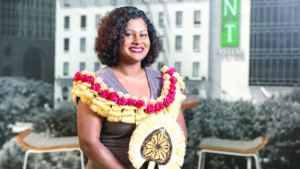By Dallas ISD Staff Reports
Born in Fiji, Lily Maminabulewa was five years old when she moved with her family to Northern California. Leaving at such a young age, she remembers little about that time except saying goodbye to her grandmother, who was “very emotional” for reasons young Lily did not yet understand.

Photo courtesy of Dallas ISD
The eldest of five children, Maminabulewa was the first in her family to graduate from college. She is quick to note that she does not fit the mold often assigned to Asian Americans and Pacific Islanders. “People just assume, ‘Oh, you’re Asian, you’ll be a lawyer or a doctor or an engineer!’ And that was not my story at all. I knew I was going to be a teacher.”
So after attaining her degree in liberal arts from Sonoma State University near her home, she signed on with Teach for America, which brought her to Dallas ISD seven years ago. With a two-year commitment to Teach for America, Maminabulewa taught at Whitney M. Young Elementary, then at Nancy J. Cochran Elementary, and completed her master’s degree in education at SMU with a concentration in early childhood literacy.
Preparing the Environment
Today, she is a “blended primary guide,” teaching 22 three-year-olds, four-year-olds, and kindergarteners in a mixed-age classroom. In practical terms, that means she provides the environment for her young students at Downtown Montessori at Ida B. Wells to have concrete experiences that support their development — in math, language, reading, science, culture and practical life.
“The Montessori curriculum follows the developmental needs of the child,” Maminabulewa says. Teachers are called guides because “it is truly child-centered, and the adults are guiding them. It’s my job as a guide to provide them with a prepared environment to nurture learning.”
Joking that she probably has “the ashiest knees of anybody you’ll ever see,” she explains that she can often be found on the floor with her students, literally at their level providing hands-on experiences that help them make the connections required for learning. “I’m not at the board teaching my kids. All of my lessons are given individually or in small groups.”
Because her pupils progress at their own rate, she said, “I have four-year-olds in my class who can read. My Montessori students start to read whenever they are ready. It’s a partnership between us and the parents.
Preserving the Culture
There is room in the curriculum for culture as well. “There’s a lot of value placed on culture, and it is linked to a lot of materials in the Montessori classroom,” she says. “Storytelling is a very big part of the Montessori curriculum. So are language, music and art. It’s definitely something I share with my students.
“In my classroom, I keep folders with maps and information about the continents, culture cards showing that there are people just like us in the world who live on these other continents, and their experiences might be a little different, but we have lots of things in common.”
On a bulletin board in her room is an important cultural art piece from her native country — a masi, a hanging textile made from dried mulberry bark. Women in the village in Fiji make these hangings, all by hand. They use everything in nature to make the dyes and all the designs.
“Other cultures in the South Pacific also have masi, also sometimes called tapa. Samoans have it, Tongans have it, but Fijians have the prettiest,” she says with a mischievous smile. “Ours is the most beautiful. We are the most creative.”
